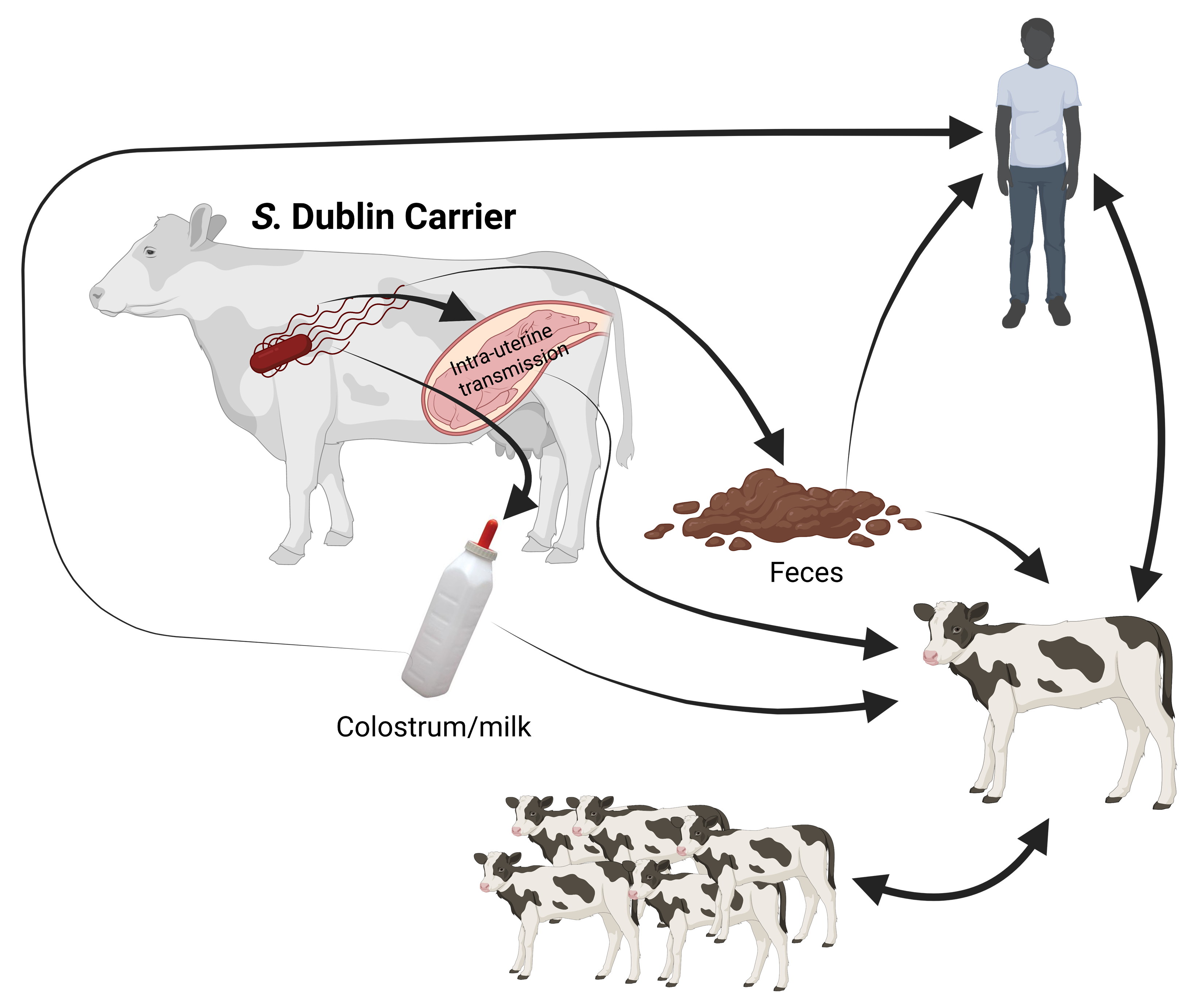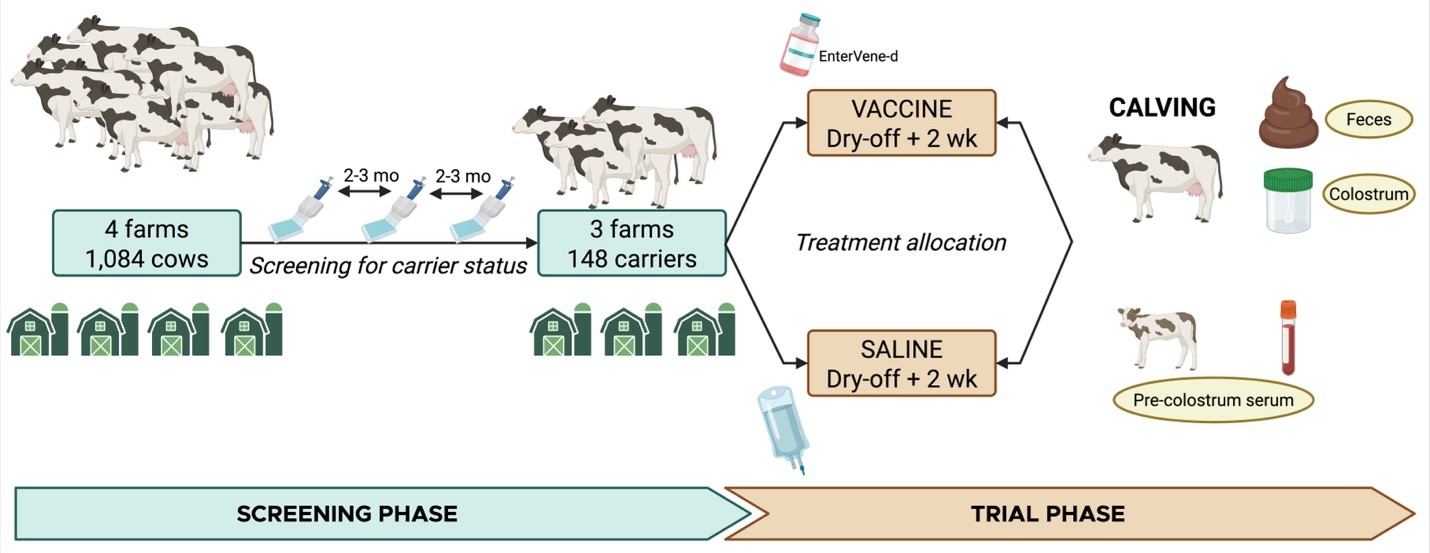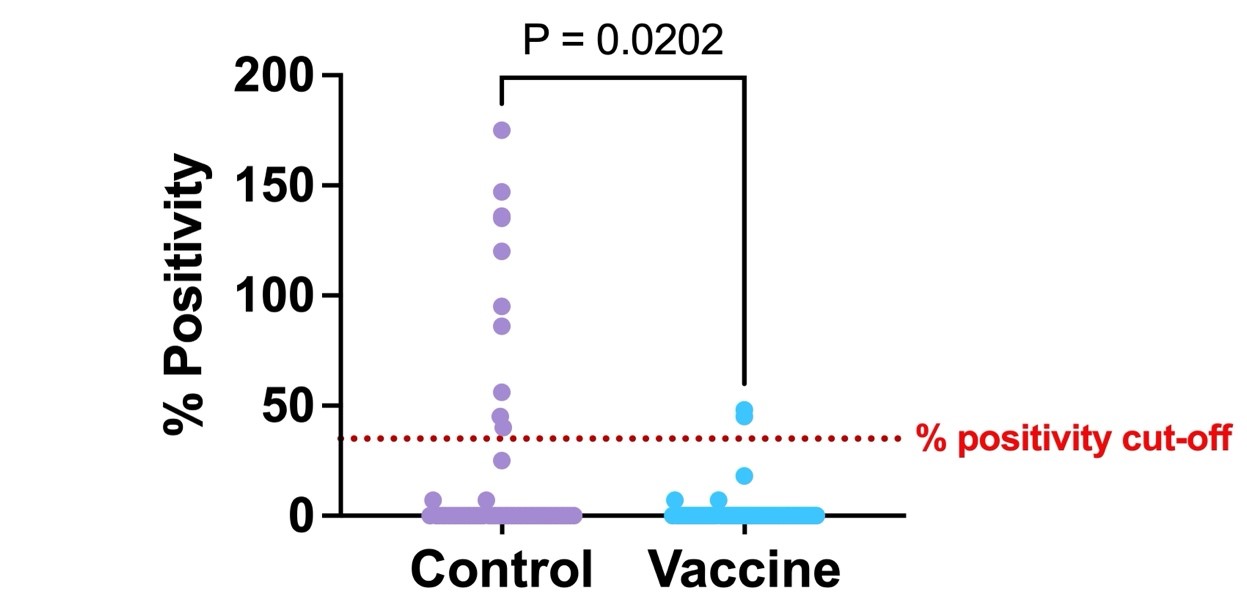Focusing on latent carriers for controlling Salmonella Dublin in dairy herds
Field study on vaccine efficacy to reduce in utero transmission.

Salmonella Dublin, a host-adapted Salmonella serotype in cattle, has become substantially more prevalent in dairy and calf-rearing facilities in the United States since 2012. S. Dublin bacteria isolated from American farms commonly exhibit multidrug-resistant (MDR) characteristics. This multidrug resistance substantially complicates the treatment and control of salmonellosis due to S. Dublin infection because no antimicrobial effective against S. Dublin can be legally administered to cattle in the U.S.
S. Dublin is a zoonotic infection, meaning that infection in cattle also presents a potential risk to human health. In this article, we summarize our recent study exploring the use of a commercially available S. Dublin vaccine (EnterVene-d; Boehringer Ingelheim Animal Health) to reduce disease transmission in dairy farms.
Importance of Salmonella Dublin
In 2014, the United States Department of Agriculture’s National Animal Health Monitoring System conducted a cross-sectional study of 234 farms nationwide. S. Dublin was present in 0.7%, 6.7% and 1.8% of the operations, milk samples and milk filters, respectively. Additionally, S. Dublin has been the most common Salmonella serovar isolated from bovine samples at the Michigan State University Veterinary Diagnostic Laboratory between 2018 and 2022, representing 10–20% of all bovine Salmonella isolations. (Figure 1A).

S. Dublin has become one of cattle's most important MDR bacteria in North America. MDR S. Dublin reduces the success of treatments, delays recovery and increases mortality and cost of treatment in humans and cattle. S. Dublin has a 43% higher MDR prevalence than other Salmonella isolates. The National Antimicrobial Resistance Monitoring System reported that among S. Dublin isolates, 84% were resistant to five or more classes of antimicrobial drugs and 57% were resistant to seven or more. Furthermore, a 29 to 79% increase was observed in the proportion of isolates resistant to one or more antimicrobial classes when comparing 1996-2004 with 2005-2013. U.S. isolates of S. Dublin are generally susceptible to gentamicin, amikacin, cefoxitin, cephalothin, enrofloxacin, meropenem and azithromycin (Figure 1B).
Even though this pathogen is susceptible to enrofloxacin (sold as Baytril), this drug is only allowed to treat bovine respiratory disease pathogens (specifically Mannheimia haemolytica, Pasteurella multocida, Histophilus somni and Mycoplasma bovis) in non-lactating cows and dairy replacements younger than 20 months. Hence, enrofloxacin is not labeled as a treatment for S. Dublin infections and the extra-label use of this drug is prohibited for American food animals.
Although most producers and veterinarians often treat respiratory diseases without a pathogen isolation diagnosis, current U.S. regulations imply that enrofloxacin cannot be used when S. Dublin is suspected or confirmed. Thus, disease prevention practices have special relevance for this condition given the limitations of treating infected animals.
As a zoonotic bacterium, S. Dublin can cause rare but severe illness in humans, commonly characterized by acute gastroenteritis and bacteremia (bacterial presence in the bloodstream). The case fatality for S. Dublin has been reported as the highest compared to other Salmonella enterica serotypes. The US Foodborne Disease Active Surveillance Network determined an increase in the incidence of human S. Dublin by 7.6 times from 1968 to 2013. The same study also determined a rise in hospitalization and mortality.
Because S. Dublin is resistant to common antibiotics used in humans and animals, it can severely affect human health and compromise medical treatment. Consequently, it is fundamental to prevent and reduce the risk of infection from cattle to farm workers, animal caretakers, and from animal-derived food to humans.
Salmonella Dublin transmission
S. Dublin infection in cattle can cause respiratory disease and septicemia (blood poisoning). The disease is transmitted by two major routes: oral and vertical. In the oral route, susceptible cattle ingest the bacteria through contact with materials contaminated by feces or other bodily fluids (e.g., milk, saliva, nasal secretions) from infected animals. In the vertical route, infected pregnant cows transmit the disease to their offspring in utero. This can result in abortion in the last trimester of gestation or the birth of congenitally infected calves. Aerosolized transmission is also possible, especially among calves housed in tight, confined spaces.

Latent carriers of Salmonella Dublin
Calves that survive the infection are highly likely to become asymptomatic carriers for life, shedding low numbers of bacteria in their secretions for years. This potential for asymptomatic infection and latent carriers of disease creates important challenges in managing S. Dublin transmission. Latent carrier cows infect calves in utero and shed bacteria during calving. Thus, controlling the spread of S. Dublin from latent carriers to newborns is needed to reduce disease transmission in affected herds. We recently completed a field study on four commercial dairy farms to determine the impact of vaccinating S. Dublin latent carrier cows during late pregnancy on S. Dublin in utero transmission and bacterial shedding at calving.
This randomized clinical trial took place from June 2022 to June 2023 and consisted of two phases. The screening phase involved the identification of S. Dublin latent carriers, whereas the trial phase included the treatment allocation and sample collection.

Screening phase
A random sample of 250 to 280 cows stratified by lactation group (1st, 2nd, or 3rd and greater) and proximity in expected calving date were screened for S. Dublin carrier status at each of the four enrolled farms, for a total of 1,096 cows. Latent carriers are confirmed by detecting sustained elevated antibodies against S. Dublin for long periods of time. Thus, three milk samples from each cow were collected at two-month intervals as part of the regular DHI testing. Cows testing positive in all tests were classified as latent carriers. Overall, 14.6% of the cows tested were considered latent carriers. However, this number as very variable among farms, and one farm was excluded due to the low number of latent carriers.
Trial phase
Carriers in each herd were randomly allocated to the vaccine or control group. Vaccine cows received 2 mL of a commercial live culture S. Dublin vaccine (EnterVene-d; Boehringer Ingelheim Animal Health) subcutaneously (SC) within seven days of dry-off and a booster 14 days after the primary vaccination per label. Control cows received 2 mL of saline SC at the same times. All animals enrolled in the study were managed according to each farm’s protocols before, during and after parturition. Enrolled cows were maintained in the pens with their herd mates. At calving, feces and colostrum from the enrolled cows were collected, and a 10 mL blood sample from the calf was also collected before colostrum intake. Feces and colostrum were subjected to bacterial culture at the MSU Veterinary Diagnostic Laboratory, and pre-colostral blood samples were analyzed for antibodies against S. Dublin. Intrauterine transmission was defined when calves had a positive result on S. Dublin antibody at birth.
Results
Latent carriers vaccinated at dry-off with a commercial live culture S. Dublin vaccine were five times less likely to give birth to a seropositive calf. The concentration of S. Dublin antibodies was also lower in calves born to vaccinated carriers than in calves born to control carriers. Notably, 17.2% of calves born to cows in the control group were already infected at birth. Previous reports indicated up to 50% vertical transmission in Salmonella-infected cattle. Although our number is lower, it likely underestimates the actual vertical transmission, as it would be possible for in utero infection to occur close to calving, thereby not allowing the fetus sufficient time to mount an immune response that results in measurable antibodies at birth. Nevertheless, our findings highlight the relevance of the vertical transmission route for this disease, as many calves that would not ... Contrary to our expectations, we did not identify S. Dublin in feces or colostrum from latent carriers via traditional bacterial culture or molecular PCR diagnostic methods. These results make us question the identification of latent carriers based on repeated milk antibody testing, the sensitivity of the methods available to detect S. Dublin via bacterial culture and/or the relevance of bacterial shedding from latent carriers at the time of calving on disease transmission. We only collected fecal samples at the time of calving, and it is possible that bacterial shedding could have started later. However, this would have a limited impact on disease transmission to the newborn in farms where dams and calves are separated shortly after birth.

Conclusions
Vaccinating S. Dublin latent carrier cows at dry-off with a commercial live culture vaccine reduced intrauterine transmission to calves by 81%. Further research is needed into the role of vertical transmission on disease dynamics and the role of latent carriers in infecting newborn calves through the fecal-oral route in the maternity area at birth. Special thanks to the farms that participated in this study and CentralStar Cooperative for facilitating access to DHIA milk samples used for S. Dublin latent carrier screening. Learn more about our lab and research at abuelolab.com.



 Print
Print Email
Email





